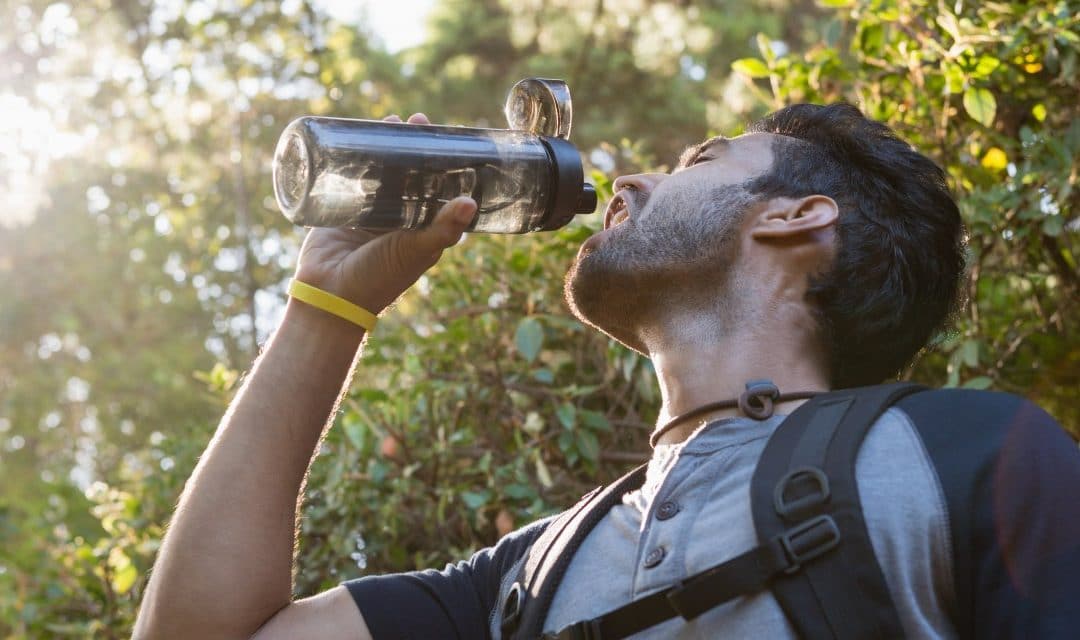Last updated on August 18th, 2021
Whether you’re going out for a leisurely walk in the park, hitting the hiking trails for a few challenging miles, enjoying biking paths, playing sports, or just working outside in the yard, there’s a common, important factor to consider: Hydration! Without proper hydration, a fun day of outside adventures can quickly turn dangerous. In this article, we’ll take a look at the following topics to help you stay hydrated outdoors:
Why is Hydration Important?
It’s no secret that water is essential to sustaining life. In fact, the adult human body is composed of about 60% water. A child’s body is composed of up to 75% water.
A person may be able to live for weeks or months without food. However, they are likely to only survive an average of three days without water. Many other factors can influence this estimate as well. Temperature, climate, altitude activity level, age, weight, and overall health all play a role in survival ability.
The human body needs water for almost every function. Staying properly hydrated is essential for regulating body temperature, delivering oxygen to working muscle and nerve tissues, keeping the brain alert and functioning correctly, lubricating joints, and helping the body eliminate waste via the liver and kidneys.
What Are The Signs of Dehydration?
Dehydration can come on quickly. You may not even realize some of the early signs as being related to dehydration. What may start out as mild fatigue and a dry mouth can turn into dizziness, confusion, and poor judgment in a matter of a few minutes.
If you’re out on a hiking trail or in a secluded area and you’re not properly prepared, this scenario could turn deadly in an instant. Be sure to familiarize yourself with the early signs of dehydration. That way, you’ll be able to recognize it and prevent the potentially life-threating symptoms of severe dehydration in yourself and others.
Early Signs of Dehydration
- Increased thirst and dry mouth
- Tiredness or fatigue
- Headache
- Irritability
Signs of Severe Dehydration
- Decreased sweating ability
- Dizziness or lightheadedness
- Stumbling and loss of coordination
- Mental confusion
- Nausea
- Decreased urine output
- Muscle cramps
How to Stay Hydrated and Prevent Dehydration
Now you know why hydration is so important and the dangerous health consequences dehydration can cause. Next, let’s take a look at how to prevent dehydration before it starts.
Get Ahead of The Game: Pre-hydrating
The best way to prevent dehydration is to start pre-hydrating an hour or two before you plan to start exercising outdoors. The general recommendation is to slowly drink 16 to 24 ounces of water one to two hours before activity. Aim toward the upper end of that limit if you are hiking or exercising first thing in the morning, as you will likely be dehydrated from sleeping overnight.
How To Stay Hydrated During Activity
According to this article written by Megan Stump, an REI Outdoor School Instructor, the best way to stay hydrated during hiking or outdoor exercise is to sip small amounts of water very frequently. Drinking small amounts of water every 15 to 20 minutes helps your body hydrate more effectively than chugging a large amount of water at one time, which can end up causing overhydration and is more harmful than helpful.
In fact, drinking too much water too quickly can dilute your blood and cause hyponatremia, a dangerous drop in sodium, which is an electrolyte critical to maintaining proper hydration levels and electrical activity within the body. Symptoms of hyponatremia are similar to those of dehydration and include nausea, confusion, headache, fatigue, muscle weakness, spasms, or cramps. In rare, severe cases, it can even cause seizures or a coma.
How Much Water Should You Drink?
Now that we’ve discussed the dangers of both dehydration and overhydration, let’s address this important question: So, how much water should you drink? The answer depends on several factors, including the type of exercise or activity you’re doing, the climate and altitude you’ll be exercising in, the rate at which you sweat, and the duration and intensity level of the exercise you’ll be performing.
A good general recommendation for moderate-intensity exercise at moderate temperatures is to drink enough to satisfy your thirst or approximately half a liter (about 16 oz.) of water per hour. If you’ll be performing more strenuous exercise at higher temperatures or altitudes for a prolonged period of time, it is advisable to drink about a liter of water per hour, following the “sip slowly and frequently” rule to stay hydrated.
Remember, each body is different, so you may need more or less water than the average recommendation. Use these guidelines to help you plan and pack the right amount of water for your activities. Don’t forget to pay attention to your thirst, the way you feel, and your level of performance to further guide your hydration decisions.
How to Carry Water While Exercising Outside
One of the best ways to remind yourself to sip water frequently is to keep water easily accessible. Carrying a backpack or hiking pack with side pockets for water bottles is a good idea. Choose an insulated stainless steel water bottle to keep water cold even on really hot days. Both the Klean Kanteen Wide-Mouth bottle and the ThermoFlask bottles are insulated and easy to transport.
Another excellent way to make drinking water easy while hiking, biking, or working outdoors is with the use of a hydration pack. Hydration packs consist of a backpack with a removable water bladder made of a flexible plastic material. The water bladder has a hose that allows the user to drink water easily while keeping the hands free. This is my favorite way to stay hydrated outside.
Because high-quality hydration packs can get a bit pricey, many people (myself included) prefer to use a more budget-friendly, hydration-compatible backpack and invest in a high-quality water bladder to insert in the pack. I’ve successfully used this daypack with water bottles in the side pockets, snacks and light rain gear in the larger compartments, and a high-quality water bladder in the hydration sleeve for several hikes. It’s sturdy and economical!
My personal favorite hydration bladder is the Platypus Big Zip EVO. This bladder is available in 1.5 to 3-liter capacities, letting you carry enough water to stay hydrated even on longer outdoor excursions. It is durable and easy to fill. BONUS – It does not taste like plastic, which is hugely important to me! It is also compatible with the daypack pictured above. While these items may be my favorites and I recommend them for durability and ease of use, be sure to find the gear that best fits you and your outdoor needs.
How to Filter Water Outside
It’s always best to plan ahead and bring the right amount of water with you when exercising outside. But occasionally things happen – you miscalculate your water needs, your hike takes longer than expected, you end up drinking all of your water too quickly, or you share your water with someone else who didn’t prepare properly.
Regardless of the reason, if you’re planning to be exercising outdoors under strenuous conditions for any significant length of time, running out of water could really put you in a bind. In this case, it’s smart to carry a portable water filtration system with you.
There are several types of portable water filtration systems available. Most are fairly lightweight, gravity-fed or squeeze-powered, and are easy to use. My top three picks include the Sawyer Squeeze filter, the Katadyn BeFree Bottle, and the Platypus GravityWorks filter. Read below for details on these three systems. Also, be sure to check out the “Best Backpacking Water Filters & Purifiers of 2019” gear guide by Switchback Travel.
Sawyer Squeeze Filter: This is a lightweight, easy-to-use filter that is highly effective. It removes greater than 99. 99999% of all bacteria and 99. 9999% of all protozoa to make water from lakes, streams, and rivers safe to drink.
To use the Sawyer Squeeze, simply fill up the pouch at a lake, stream, or river. Then, screw the filter directly onto the pouch, then squeeze the bag to filter water into a bottle. The Squeeze filter also has a push-pull cap for convenient drinking directly from the filter. It attaches directly onto standard threaded water bottles, too. The filter unit is good for up to 1 million gallons of water. (Wow!)
Katadyn BeFree Bottle: The Katadyn water filtration system consists of a collapsible water bottle with a removable filter and drinking spout. It is lightweight, compact, and easy to use.
To use the Katadyn BeFree, simply unscrew the filter cap and fill the bottle with water from a lake, stream, or river. Next, screw the filter cap in place. Now, you can drink directly from the filter cap as you would a regular water bottle. You can also squeeze the water through the filter and into other water bottles. The filter is fast, free-flowing, and filters approximately 1,000 liters before it needs to be replaced.
Platypus GravityWorks: Unlike the Sawyer and Katadyn squeezable water filters, the Platypus GravityWorks is a gravity-fed filtration system with a much larger capacity. This option is great for filtering water for a larger group of people or when needing clean water for camping or cooking.
The GravityWorks consists of two large reservoirs connected by a hose with an inline filter. To use the filtration system, fill the “dirty” reservoir with water from a lake, stream, or river. Hang the “dirty” reservoir higher and the “clean” reservoir lower, and let gravity move the water through the filter. The GravityWorks can filter 4 liters of water in 2.5 minutes. It has a filter life of approximately 1,500 gallons.
Replenishing Electrolytes
A crucial part of staying properly hydrated includes replacing electrolytes. This is especially important when exercising outdoors, performing long bouts of strenuous exercise, exercising in very warm, humid, or cold climates, or at a higher altitude where the air is drier and thinner.
We lose electrolytes when we sweat, particularly sodium and potassium. If the body’s electrolyte levels are too depleted, it can cause muscle cramps, poor endurance, and the symptoms of nausea, confusion, and headaches associated with hyponatremia.
You may think reaching for the nearest sports drink to replenish essential electrolytes is the answer. However, most commercial sports drinks contain an unhealthy amount of refined sugar, artificial chemicals, and color dyes that aren’t good for our health or athletic performance.
In order for our bodies to effectively absorb electrolytes in the small intestine, a small amount of natural sugar (about 1-2 grams) must be present. This is the science behind why sports drinks contain sugar. The problem is that they contain way too much sugar.
Consuming sports drinks loaded with 30+ grams of sugar isn’t good for anyone and can cause GI upset when exercising. The low or no-sugar sports drinks aren’t good options either. Artificial sweeteners and added chemicals to improve the taste.
If you’re looking for a more healthy and natural way to stay hydrated, replace electrolytes, and avoid refined sugar, artificial sweetener chemicals, and fake dyes, then keep reading for some helpful solutions.
Healthy Electrolyte Supplements
There are several types of electrolyte replacement supplements on the market. Let’s take a look at which ones are effective and healthier for you.
Coconut water: Pure, unsweetened coconut water is high in potassium and magnesium and low in natural sugars. It has far fewer calories than standard sports drinks. However, coconut water is low in sodium, which is an essential electrolyte to replace when sweating. Add a pinch of pink Himalayan sea salt to 8 oz of coconut water to balance out its electrolyte content and you have a complete, natural rehydrating drink.
Powdered coconut water: Pure, powdered coconut water is a more cost-effective way to enjoy the benefits of coconut water for hydration. Individual packets or small Ziplock bags of powdered coconut water are also quite convenient to keep in your backpack. They can be added to water as needed while hiking or exercising. As with liquid coconut water, make sure to add a pinch of pink Himalayan sea salt to up the sodium content for optimal hydration. This is my favorite brand:
Liquid electrolyte drops: Liquid electrolytes contain nothing but sodium, magnesium, potassium, and chloride. There are no additives or sugars. It’s easy to add a few drops to your water. Note that since there are no added flavors or sweeteners, liquid electrolytes taste somewhat salty in water. To add the necessary small amount of natural sugar for optimal absorption and to improve the taste, just add about 1/4 cup of any natural fruit juice to your water along with the electrolyte drops. I use this brand and find it works well.
Electrolyte salts capsules: If you like the benefits of liquid electrolytes but prefer to avoid the salty taste, electrolyte salts capsules are the way to go. These capsules contain magnesium, calcium, chloride, sodium, potassium, zinc, and vitamins B6 and D3. Take them before, during, and after exercise with water to help you stay hydrated.
Nuun Sport tablets: Nuun Sport is an electrolyte-rich tablet that dissolves in water. Each tablet contains sodium, potassium, magnesium, calcium, and chloride electrolytes for hydration. Nuun tablets are lightly flavored with natural flavors, mildly sweetened with stevia extract, and contain one gram of dextrose to improve cellular absorption of electrolytes. Just drop one of the effervescent tablets into 16 oz of water and enjoy a refreshing, lightly flavored hydrating drink without all the chemicals, sugar, and additives of traditional sports drinks.
Cure Hydration Mix: Cure Hydration Mix is an all-natural, Paleo-friendly electrolyte powder made with organic powdered coconut water, pink Himalayan sea salt, and natural flavors. It is sweetened with monk fruit extract and stevia. Cure comes in convenient, single-use packets in lemon, mixed berry, and ginger turmeric flavors.
DIY Electrolyte Drinks
If you prefer to make your own electrolyte drinks, here are two great recipes that are easy to customize to your taste and will have you feeling hydrated quickly:
Lemon-Lime Electrolyte Water
- This recipe is adapted from healthline.com. Mix all ingredients together and serve chilled.
- 2 cups cold water
- 1.5 cups pure, unsweetened coconut water
- 1/4 cup lemon juice
- 1/4 cup lime juice
- 1/4 tsp pink Himalayan salt
Paleo Citrus Electrolyte Drink
- This recipe is adapted from dontmesswithmama.com. It has quite a bit more natural sugar from the fruit juices but is great for hydrating and getting a few natural carbs after activity. Mix all ingredients together and serve chilled.
- 2 cups cold water or unsweetened coconut water
- 1/2 cup no sugar added orange juice
- 1/4 cup lemon juice
- 2 TBSP honey (or a splash of liquid stevia to decrease sugar content)
- 1/8 tsp pink Himalayan salt
Summary
In summary, staying properly hydrated is extremely important, especially when exercising or working outdoors. Make sure to pre-hydrate before activity to prime your muscles and organs for exercise. Also, drink appropriate amounts of water and replenish electrolytes during and after activity to optimize energy, performance, and recovery. To avoid unhealthy sugars, chemicals, and dyes, ditch the sports drinks and try the Paleo electrolyte supplements and drink recipes listed above.
This post may contain affiliate links. This means if you click on a link and make a purchase, I will receive a small commission, at no cost to you, that makes it possible for me to keep the Campfires and Cast Iron site up and running. Please see our disclosure policy for details.














